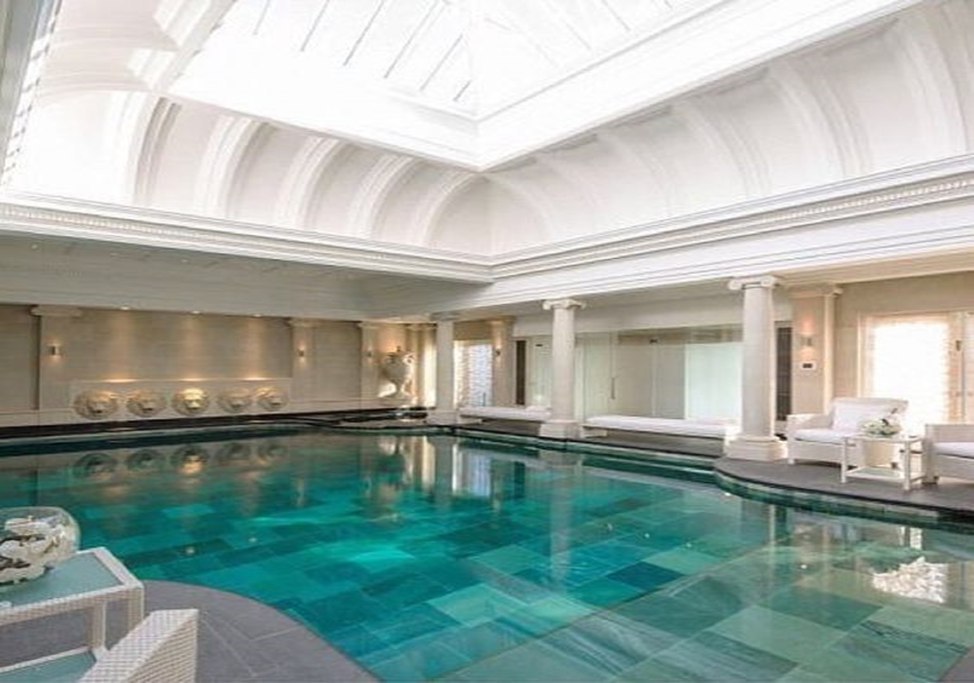The decoration of the pool with tiles looks very beautiful, and belongs to the more expensive, but popular types of decoration. The pool, decorated with multi-colored tiles, is a good addition to the landscape design of the territory. In terms of service life, it exceeds the rest of the materials. However, even the strongest tiles, with the wrong laying technology, can lead to a bad result.

Choosing a tile
The choice of material for finishing the pool is very important. There is a huge range of tiles on the market and choosing the right one is very difficult.
Tiles for interior decoration of the pool can be:
- Ceramic clinker. Very durable porous material with double firing. Suitable for interior decoration, because, unfortunately, it is afraid of low temperatures, so it is used in indoor pools. For finishing the bowl on the walls, clinker with a glazed surface is suitable, and for the floor, glazed with an anti-slip top. For rooms, ordinary rough clinker is used for the floor and stairs.
- Porcelain. A mixture of white clay and quartz sand is treated with high temperatures, which results in a durable tile with water-repellent properties. Such tiles are ideal for the walls and bottom of the pool. Very easy to care for, dirt and plaque do not accumulate on it.
- Glass mosaic. This is the most successful and durable tile, thanks to the many small glass fragments collected together. Water does not penetrate the glass surface, and the small area of the broken elements allows it to withstand high water pressure. If the tile breaks, only the damaged parts are easily replaced. Glass tiles withstand high and low temperatures, so mosaic tiles are used for laying tiles in an outdoor pool. Thanks to the grout, the surface is rougher, which makes it convenient for use in the pool and on stairs.
Choosing glue
In order for the tiles not to crack during the operation of the pool, it is necessary to choose the right waterproof glue. This is usually a special composition based on epoxy resin or cement with resins. The glue should also play the role of a waterproof base. This is an additional hydroprotective layer. The peculiarity of the glue for finishing the pool bowl is its ability to remain rubberized even after complete drying and cover the bowl area with a film. Such a composition is able to withstand water pressure and prevent the tile coating from cracking. Usually, preference is given to cement-based glue with additives. They are easier to work with, unlike epoxy, which hardens quickly. Although the latter is considered more reliable.
Grout selection
Grout for pool tiles must be waterproof. The grout can be cement-based or epoxy-based. The main thing is that it is resistant to chlorine and sea water, and also remains elastic, which will help withstand water pressure. It is imperative to have an antibacterial additive in the composition so that mold does not develop.
Surface preparation
Before tiling a swimming pool, it is necessary to prepare the base. This preparation is carried out in several stages:
- Firstly, the pool bowl made of concrete has many cracks and irregularities. Therefore, after drying, it is necessary to walk through the concrete solution again and level the walls and bottom of the bowl.
- Secondly, to prepare the pool bowl for use for many years, it is necessary to perform waterproofing. Penetrating waterproofing, which is based on a sand-cement composition, copes well with this process. Such impregnation penetrates the concrete by several tens of centimeters, helping to eliminate microcracks and protect the bowl from leaks in the future.
- Thirdly, waterproof plaster will help to completely level the base of the bowl. It will be an ideal base for laying tiles, as well as additional waterproofing.
Tile laying technology
The principle of laying tiles is one of the important processes. The size of the joint between the tiles depends on the selected adhesive for laying. Usually the size of the joint is from 4 to 6 mm. A small space prevents moisture from seeping under the tile. Apply the adhesive to the prepared surface. The tile is laid on top. The laying process is controlled using beacons and a thread.
Floor and staircase decoration
The floor tiles in the pool and steps should be anti-slip. You should start laying from the center in a circle. It is convenient to lay the straight area around the pool with large ceramic tiles. This will speed up the work and reduce material consumption. As for the protruding parts and recesses, you cannot do without mosaic. It takes any shape well and will look beautiful when combining different tile models. For example, you can go from a light mosaic to a more saturated blue one.
Conclusion
The tile for laying in the pool has special properties, it is made of fine-pored double-fired ceramics and is covered with glass. This composition completely eliminates water absorption. And the strength and specificity of the tile are able to withstand a large load of water and temperature changes. It should not crack or fade. The color scheme is different and you can even create a panel. But as practice shows, preference is given to blue, blue and green colors in combination with white. Such a scheme gives depth and saturation to the water in the pool. But you can add a zest to your site by decorating your pool with an unusual color scheme. For example, choose red, black or gold tiles. It is advisable to lay the pool bowl with small tiles, such tiles will not crack or peel under the weight of water.

